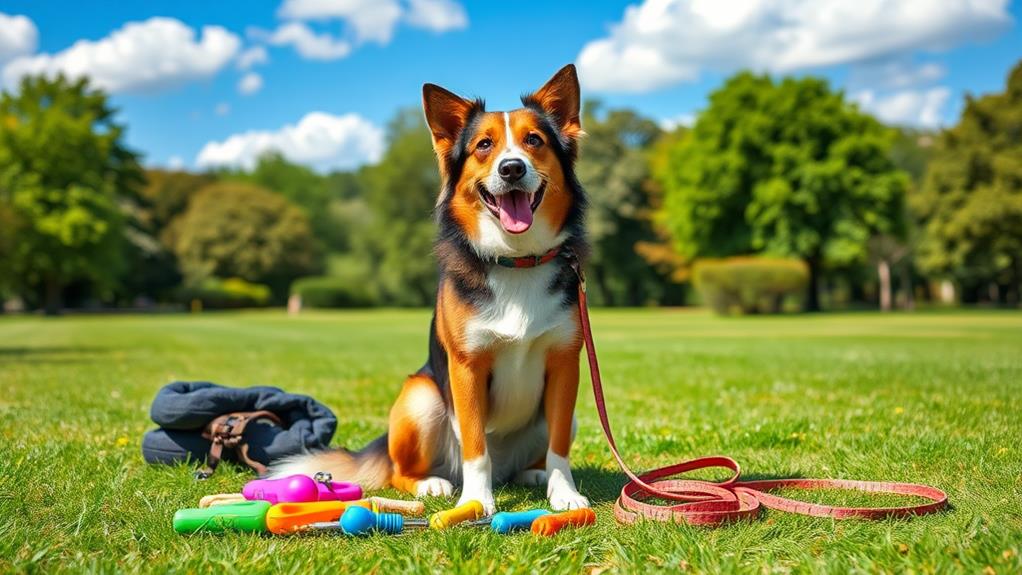Mastering the basics of dog training starts with understanding your dog's behavior. Use positive reinforcement to reward good actions, and establish a consistent routine for training sessions, playtime, and meals. Keep training sessions short—about 5 to 10 minutes—focusing on one or two commands at a time. Be consistent with your commands and tone, and involve everyone in the household. Early socialization is pivotal, too; expose your pup to various environments and other dogs. Finally, be patient and celebrate small victories. Master these tips, and you'll develop a strong bond with your furry friend. There's much more to uncover!
Understand Your Dog's Behavior
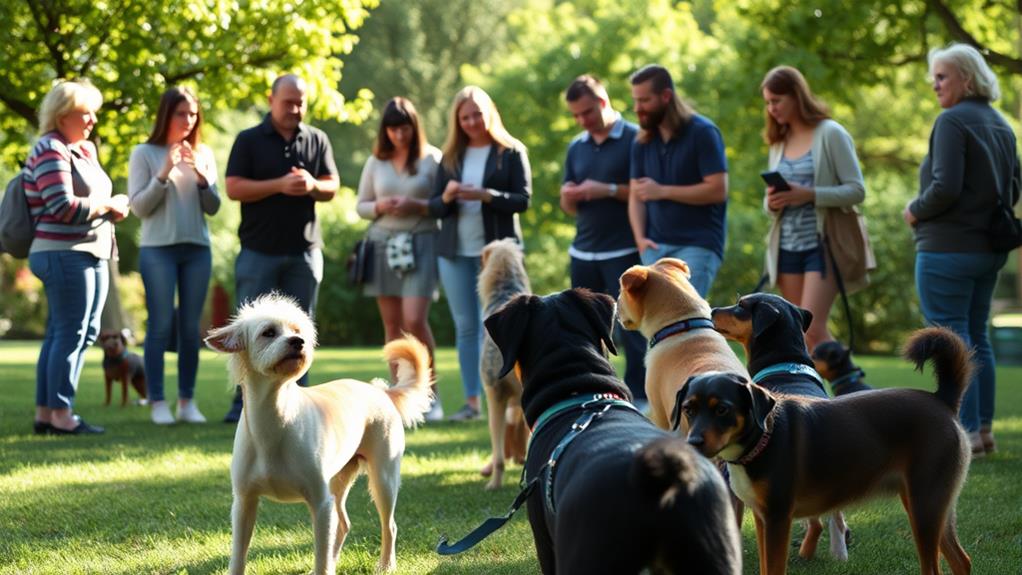
Every dog owner should take the time to understand their pet's behavior, as it's key to effective training. Your dog's actions, whether it's barking, digging, or jumping, communicate their feelings and needs. By paying attention to these behaviors, you can decipher their thoughts and emotions, which helps you respond appropriately.
For instance, if your dog barks at strangers, it might be a sign of excitement or anxiety. Recognizing this can guide you in addressing the behavior. Similarly, if your dog tends to chew on furniture, it could indicate boredom or a lack of proper stimulation. Understanding these signals allows you to provide the right environment and activities for your furry friend.
Additionally, keep in mind that a dog's behavior can vary based on their breed, age, and individual personality. What works for one dog may not work for another, so tailor your approach accordingly. Observing your dog in different situations helps you grasp their unique reactions and needs.
Ultimately, by understanding your dog's behavior, you lay the groundwork for effective training and a stronger bond between you and your pet. Invest time in this understanding, and you'll see positive results in your dog's behavior.
Use Positive Reinforcement

Understanding your dog's behavior sets the stage for effective training methods, and positive reinforcement is one of the most impactful techniques you can use. This approach focuses on rewarding your dog for desirable behaviors, which encourages them to repeat those actions. When your dog sits on command or stays by your side, give them a treat, praise, or playtime. These rewards create a positive association with the behavior.
It's essential to be consistent with your rewards. When your dog performs the desired action, respond immediately, so they connect the behavior with the reward. Timing is everything in positive reinforcement! If you wait too long, your dog mightn't understand what they're being praised for.
Also, keep in mind that different dogs respond to different types of rewards. Some might prefer tasty treats, while others might be more motivated by toys or affection. Experiment to find what works best for your pup.
Avoid using punishment or negative reinforcement, as these methods can lead to fear and anxiety, making training more difficult. Instead, focus on building a trusting relationship with your dog, and watch them thrive through positive reinforcement!
Establish a Routine
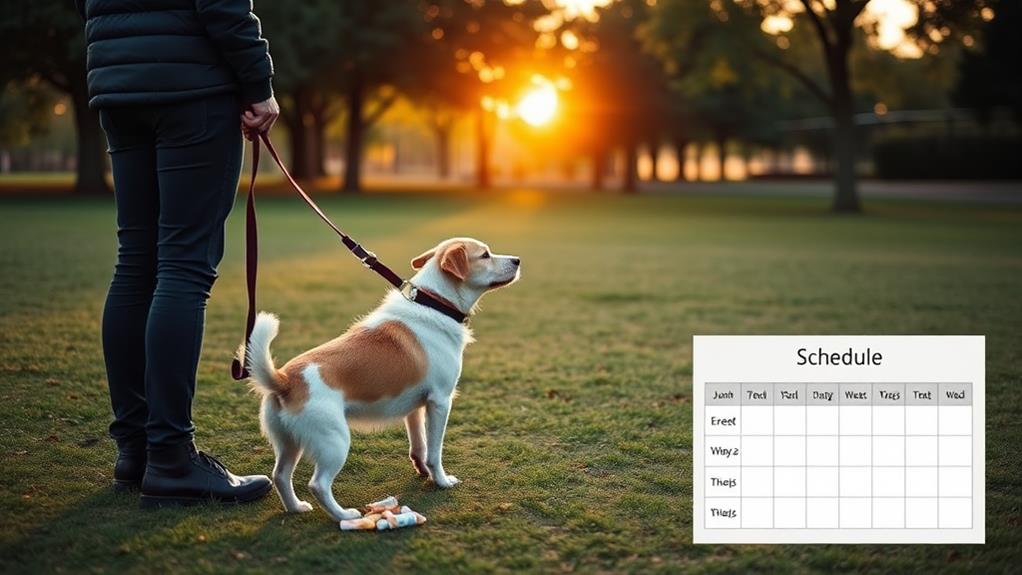
Establishing a consistent routine can greatly enhance your dog's training experience. When you create a structured environment, your dog learns what to expect, making it easier for them to understand and follow commands. This predictability not only helps with training but also contributes to your dog's overall well-being.
Set Training Times: Choose specific times each day for training sessions. Consistency helps your dog anticipate and prepare.
Incorporate Play: Include regular playtime in the routine to strengthen your bond and keep your dog engaged.
Meal Schedule: Feed your dog at the same times every day. A predictable meal schedule can aid in potty training and create a sense of security.
Exercise: Guarantee your dog gets daily exercise at consistent times. This will help them release energy and remain focused during training.
Rest Periods: Schedule downtime for your dog to relax and recharge. A well-rested dog is more receptive to learning.
Keep Training Sessions Short
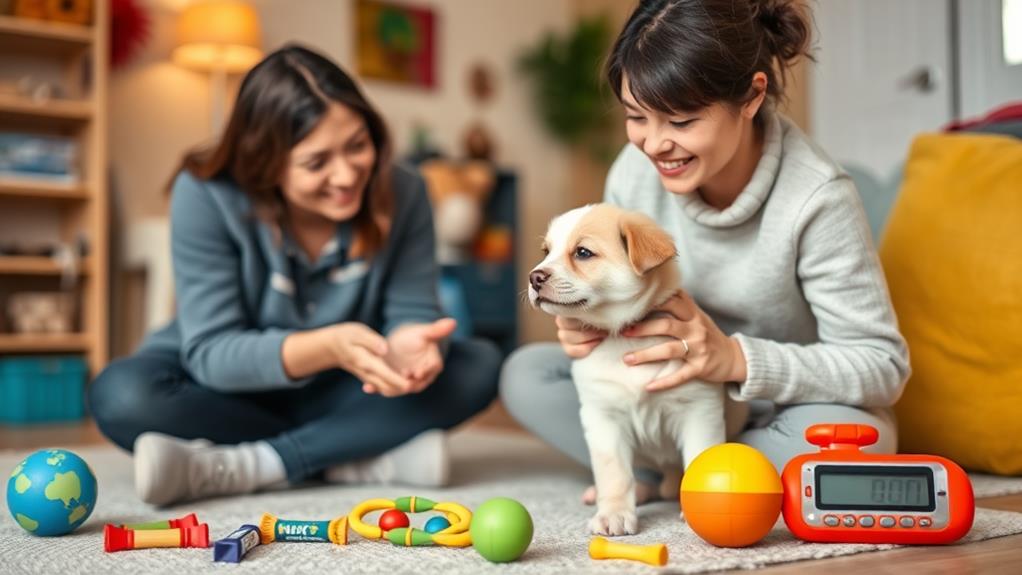
Training sessions should be brief and focused to keep your dog engaged and zealous to learn. Aim for sessions that last about 5 to 10 minutes, especially when you're just starting. Dogs, like humans, can lose interest if sessions drag on too long. By keeping them short, you'll help maintain their attention and enthusiasm.
During these quick sessions, you can concentrate on one or two commands. This focused approach allows your dog to grasp each command better without feeling overwhelmed. If they seem to lose interest, it's a good sign that it's time to wrap things up.
After a short session, end on a positive note. If your dog successfully follows a command, reward them with praise or treats. This not only reinforces their behavior but also leaves them fervent for the next session. You can always return to training later in the day.
Be Consistent With Commands
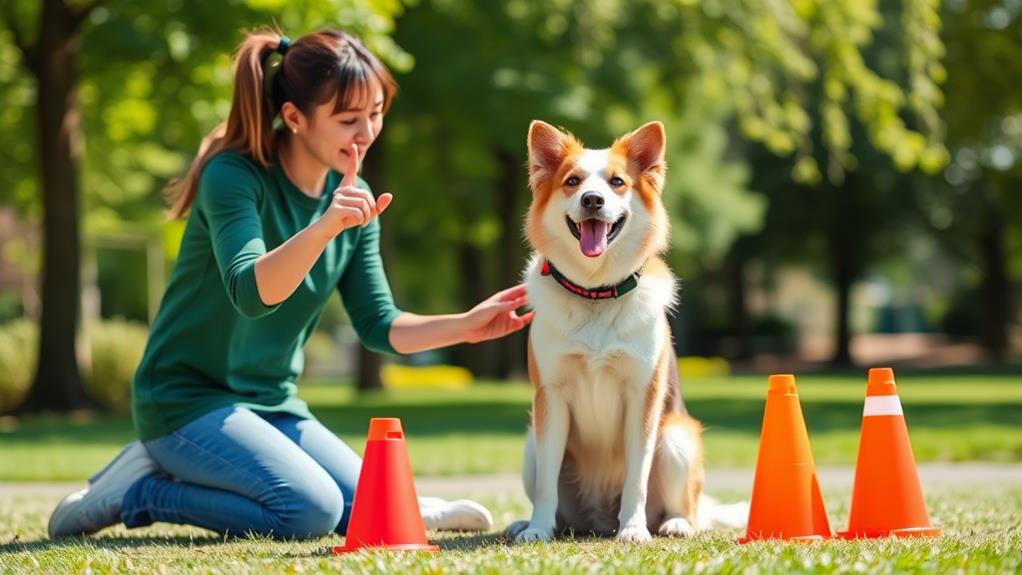
Consistency is key when it comes to teaching your dog commands, as using the same words and tone helps them learn faster. If you mix up commands or change your tone frequently, your dog may become confused and struggle to understand what you want.
To guarantee effective training, follow these guidelines:
- Use the same command: Always say "sit" instead of occasionally saying "sit down."
- Maintain a consistent tone: Use a calm and encouraging tone when giving commands; this builds trust and understanding.
- Be clear and concise: Avoid lengthy phrases. Short, simple commands are more effective.
- Limit the number of commands: Focus on a few essential commands at first, like "sit," "stay," and "come," and master those before introducing more.
- Involve everyone: Ensure that everyone in your household uses the same commands and tone to reinforce consistency.
Socialize Your Dog Early
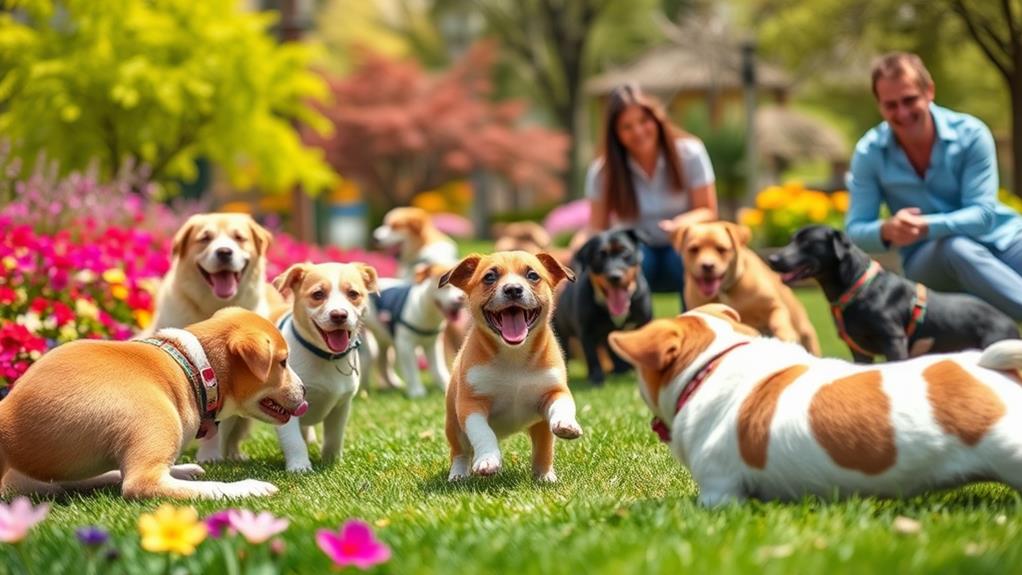
Alongside using consistent commands, socializing your dog early plays an essential role in their development. By exposing your pup to various environments, people, and other animals, you help them build confidence and learn appropriate behaviors. Start this process as soon as you bring your dog home, ideally before they reach 16 weeks of age, when they're most receptive to new experiences.
Take your dog on walks in different neighborhoods, visit pet-friendly parks, or attend puppy classes. These settings provide valuable opportunities for your dog to encounter diverse sights, sounds, and smells. When introducing your dog to new experiences, keep it positive by using treats and praise. This encourages them to associate new situations with positive outcomes.
Don't forget to introduce your dog to other pets and well-behaved dogs. Controlled interactions can help them learn social cues and proper play behavior. Always monitor their body language, and step in if they seem overwhelmed.
Patience Is Key
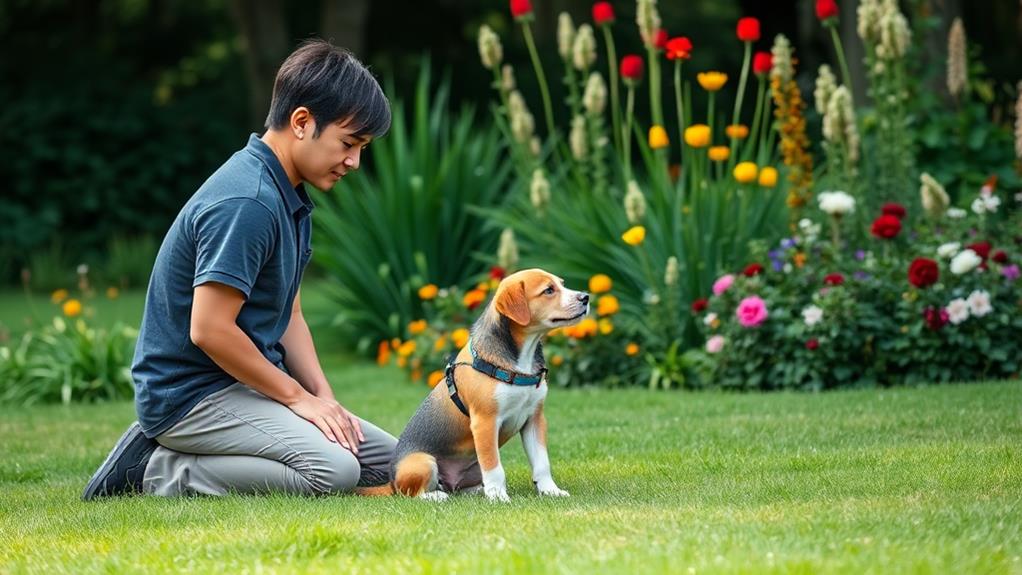
Having a dog means you'll encounter moments that test your patience, and that's perfectly normal. Training takes time, and not every session will go as planned. It's crucial to remember that every dog learns at their own pace. Embrace the journey, and focus on building a strong bond with your furry friend.
Set Realistic Expectations: Understand that your dog won't master commands overnight.
Use Positive Reinforcement: Reward good behavior consistently to motivate your dog.
Keep Training Sessions Short: Dogs have limited attention spans; aim for 5-10 minutes.
Celebrate Small Wins: Acknowledge every little improvement to keep you both motivated.
Practice Regularly: Consistency is key, so train daily if possible, even for short sessions.
Frequently Asked Questions
What Age Is Best to Start Training My Dog?
You can start training your dog as early as eight weeks old. At this age, they're enthusiastic to learn. Consistent, positive reinforcement helps them develop good habits and strengthens your bond. Don't wait too long!
How Do I Choose the Right Training Tools?
Choosing the right training tools is like picking the perfect brush for a masterpiece. You'll want tools that fit your dog's size and temperament, ensuring comfortable, effective training sessions that build trust and understanding between you both.
Can I Train My Dog Without Treats?
Yes, you can train your dog without treats! Use praise, toys, or playtime as rewards instead. Consistency and positive reinforcement are key, so keep your training sessions engaging and enjoyable for both you and your dog.
What Should I Do if My Dog Isn't Responding?
When your dog seems distant, it's like a flower wilting under the sun. Reassess your training methods, adjust your tone, and reconnect. Patience and consistency can turn that wilting flower back to blooming beauty.
How Long Will It Take to Train My Dog?
How long it takes to train your dog depends on factors like age, breed, and consistency. With regular practice and patience, you'll likely see noticeable progress in a few weeks to a few months.
Conclusion
By mastering these basics, you're setting your dog up for success and creating a strong bond. Imagine you've just adopted a shy rescue dog named Max. With consistent training and positive reinforcement, you notice him enthusiastically sitting for treats instead of hiding. This transformation not only boosts his confidence but deepens your connection. Remember, training takes time and patience, but the rewards are immeasurable. So, get started today, and watch your dog thrive!

